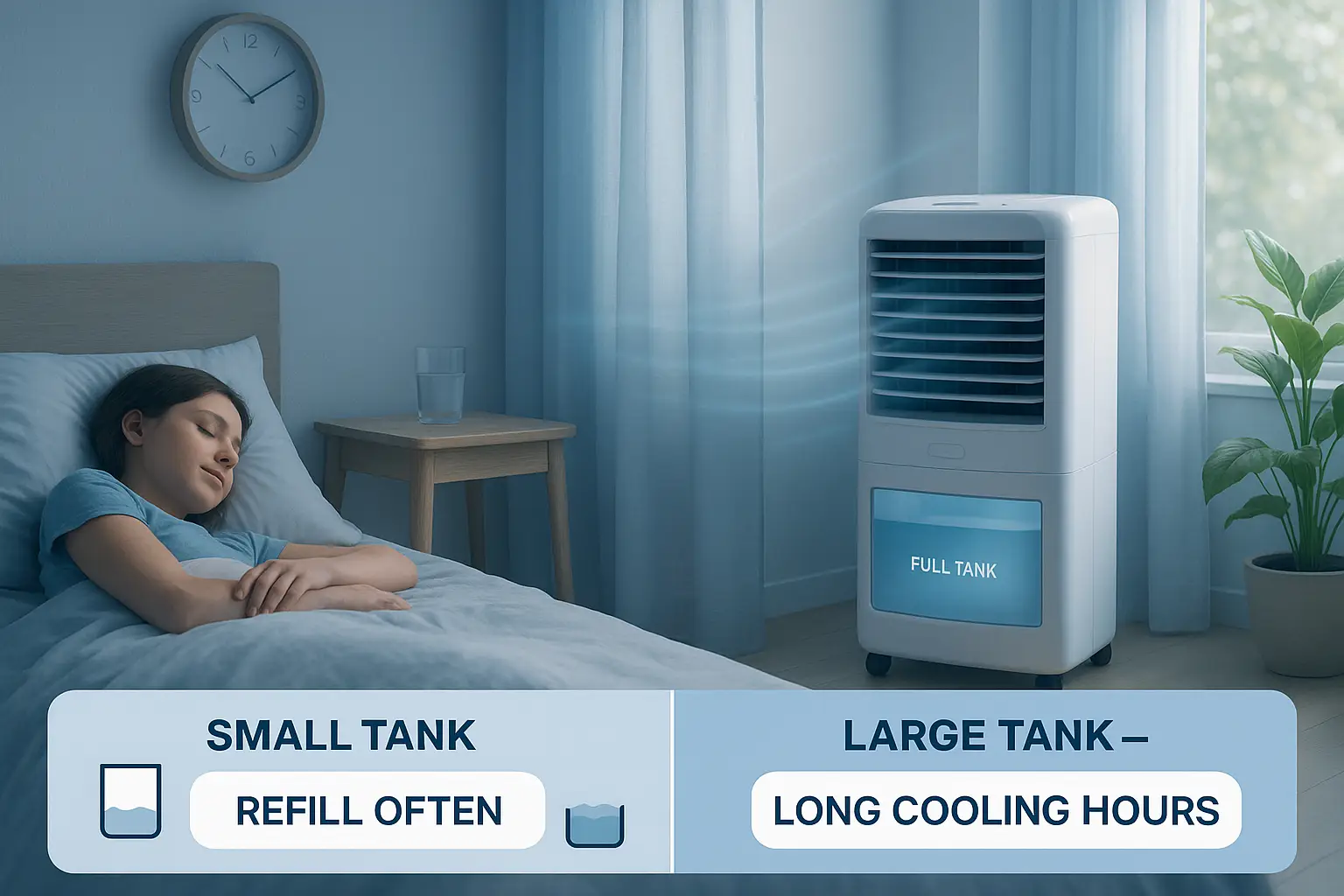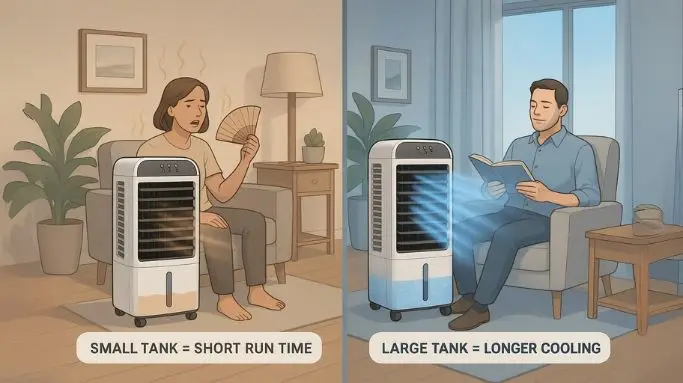When choosing an air cooler for your home or office, the water tank size is one of the most important factors to consider. While many consumers focus on features like cooling speed, energy efficiency, and portability, the water tank plays a critical role in ensuring your air cooler works effectively, particularly during extended use. Whether you’re in a region with high humidity or dry heat, the size of the water tank will directly impact the efficiency and longevity of your cooler.
In this article, we will delve into why water tank capacity is crucial when selecting an air cooler, and how it influences the overall performance and cooling experience.
1. Understanding How Water Tank Size Affects Cooling Efficiency
At the heart of an air cooler’s performance is its ability to efficiently cool the air by utilizing water-saturated cooling pads. As warm air passes through these pads, water evaporates, absorbing heat from the air and releasing cool, moist air into the room. This process works best when there is a steady supply of water, which is why the water tank size plays such a crucial role.
- How a larger water tank helps:
A cooler with a larger water tank will be able to sustain this evaporation process for a longer period without requiring frequent refills. This ensures that the cooling effect remains consistent throughout the day, especially in large rooms or during extended usage. - Challenges with smaller tanks:
A smaller water tank, on the other hand, will need to be refilled more often, which can interrupt the cooling cycle. In cases where the cooler is used for longer durations or in larger spaces, a smaller tank may not be able to keep up with the demand for cool air.
2. Matching Water Tank Size to Room Size for Optimal Cooling
When selecting an air cooler, it’s essential to consider not just the water tank size but also how it matches the size of the room where it will be used. If the tank is too small for the room, the cooler may struggle to cool the area effectively, while a tank that is too large for a small room can lead to wasted water and energy.
- Smaller rooms:
For compact spaces like bedrooms or small offices, air coolers with a smaller water tank (around 10-20 liters) are usually sufficient. These coolers can provide effective cooling without the need for frequent refills. - Larger rooms or open spaces:
In larger spaces such as living rooms, halls, or offices, a larger water tank (40 liters or more) is necessary to maintain continuous cooling. With a bigger tank, the cooler can run for a longer time without the need for constant refills, ensuring the room stays cool and comfortable.
Matching the water tank capacity to your room’s size ensures that you are using your air cooler efficiently, providing adequate cooling without unnecessary water waste.
3. How Larger Water Tanks Contribute to Less Frequent Refills
The primary benefit of a larger water tank is that it reduces the need for frequent refills. This not only ensures continuous cooling but also minimizes the hassle of constantly monitoring and replenishing the water tank.
- Continuous cooling:
Larger tanks allow the cooler to run for extended periods without interruption, which is particularly beneficial when you need the air cooler running throughout the day or night. It’s also more convenient for people who may not have the time or ability to refill the water tank frequently. - Reduced maintenance:
Frequent refills can be cumbersome, especially if you’re in a location where the air cooler is used continuously. By opting for a cooler with a larger water tank, you reduce the chances of experiencing disruptions in cooling, making it easier to maintain a comfortable indoor environment.

4. Water Tank Size and Energy Efficiency: A Balance You Need to Achieve
Energy efficiency is one of the main advantages of air coolers over air conditioners. However, this efficiency can be impacted by the size of the water tank. An air cooler that runs out of water frequently may require more energy to keep the system running, especially when trying to maintain a constant flow of cool air.
- How the tank size affects energy use:
A larger water tank typically leads to fewer refills, which in turn reduces the amount of time the cooler needs to operate at maximum capacity. By ensuring that the cooler has a consistent water supply, it avoids frequent energy-intensive cycles of restarting and re-cooling, thus maintaining energy efficiency. - Balancing water usage with cooling efficiency:
Choosing the right water tank size ensures that you strike the perfect balance between energy consumption and cooling efficiency. Smaller tanks may lead to unnecessary refills, while larger tanks provide a more consistent and sustainable cooling cycle.
5. Climate Considerations: How Different Environments Affect the Ideal Tank Size
The local climate plays a significant role in determining the appropriate size of the water tank. Areas with dry and hot climates tend to need air coolers with larger water tanks to combat the heat effectively, while more humid regions may require less frequent refills due to the natural moisture in the air.
- Hot and dry climates:
In regions with high temperatures and low humidity, air coolers work harder to produce the desired cooling effect. A larger water tank is necessary to support longer operating hours and ensure that the cooler can run effectively throughout the day without requiring constant water replenishment. - Humid climates:
In more humid environments, air coolers are less reliant on the water evaporation process since the air already contains a higher level of moisture. Therefore, smaller water tanks may be sufficient, as the need for evaporation is less intense, and the cooler can provide adequate cooling without excessive water consumption.
By understanding your climate and choosing an air cooler with the right water tank size, you can ensure that your cooling solution is both efficient and effective.
6. The Convenience of Easy Maintenance and Refilling
Larger water tanks are not only more efficient but also offer added convenience in terms of maintenance. Refilling smaller tanks frequently can be tedious, and if the cooler isn’t designed for easy water access, it can become a hassle.
- Ease of refilling with large tanks:
Coolers with larger tanks are often designed with more user-friendly features for refilling, such as easy-to-open water chambers. This makes it more convenient for users to keep the tank full without much effort. - Maintenance simplicity:
Air coolers with larger tanks typically require less maintenance when it comes to refilling, as they can operate longer between refills. This means you spend less time on upkeep and more time enjoying the comfort of a cool home or office.
7. Understanding Different Types of Coolers and Their Tank Sizes
There are different types of air coolers available, each with varying water tank sizes to suit specific needs.
- Personal and portable coolers:
Personal and portable coolers are designed for individual spaces, such as a bedroom or office. They typically have smaller water tanks (10-20 liters) but offer portability and targeted cooling for small areas. - Desert coolers:
Desert coolers are ideal for larger spaces and provide powerful cooling. They come with larger water tanks (40 liters and above) to ensure longer cooling cycles for bigger rooms and areas.
Conclusion
In conclusion, the water tank size of an air cooler is a key factor in determining its efficiency, convenience, and overall performance. Larger tanks provide extended cooling cycles, reduce the need for frequent refills, and help maintain a consistent temperature in larger rooms. By choosing the right air cooler based on the size of your space and your cooling needs, you can ensure optimal performance and energy efficiency.
When selecting an air cooler, it’s essential to balance room size, climate, and cooling requirements with the appropriate water tank capacity. Whether you’re cooling a small room or a large living space, understanding the importance of water tank size will help you make an informed decision, ensuring effective and lasting cooling for your home or office.
FAQs About Water Tank Size in Air Coolers
Why is water tank capacity important in an air cooler?
Water tank capacity is crucial because it determines how long the cooler can run without needing a refill. A larger tank allows for longer continuous operation, making it ideal for larger rooms or extended use without interruptions in cooling.
What happens if the water tank is too small for my space?
If the tank is too small, the cooler will need to be refilled frequently, especially in larger spaces. This can disrupt the cooling process, leading to inconsistent temperatures and more maintenance work.
How do I know what size water tank is right for my room?
The ideal tank size depends on your room’s size. For smaller rooms (up to 10m²), coolers with smaller tanks (10-20 liters) are sufficient. For larger spaces (over 20m²), opt for models with larger tanks (40 liters or more) to maintain continuous cooling without frequent refills.
Will a larger water tank make my air cooler more energy-efficient?
Yes, a larger water tank allows the air cooler to run for longer periods without frequent refills, which helps maintain consistent cooling and energy efficiency. Smaller tanks require more energy for refilling, leading to energy consumption spikes.
Can I use a larger water tank cooler in a small room?
While it’s generally fine to use a larger cooler in a small room, it may not be necessary. Oversized coolers can take up more space and consume more water than needed. For small rooms, a cooler with a smaller tank and more compact design may be a better fit.
How often do I need to refill the water tank in my air cooler?
The frequency of refills depends on the cooler’s water tank size and how often it’s used. Air coolers with larger tanks can run for several hours without needing a refill, while smaller tanks may require more frequent maintenance, especially during long operating hours.
Are larger water tank coolers more difficult to maintain?
No, larger water tank coolers are generally easier to maintain because they require fewer refills, meaning less frequent cleaning of the tank. However, it’s still important to regularly clean the water tank to prevent buildup of minerals and mold.
